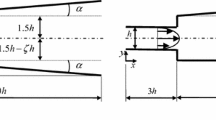Abstract
A symmetry breaking nonlinear fluid flow in a two-dimensional wall-driven square cavity taking symmetric boundary condition after some transients has been investigated numerically. It has been shown that the symmetry breaking critical Reynolds number is dependent on the time history of the boundary condition. The cavity has at least three stable steady state solutions for Re=300-375, and two stable solutions if Re>400. Also, it has also been showed that a particular solution among several possible solutions can be obtained by a controlled boundary condition.
Similar content being viewed by others
References
Albensoeder, S., Kuhlmann, H. C. and Rath, H. J., 2001, “Multiplicity of Steady Two-Dimensional Flows in Two-Sided Lid-Driven Cavities,”Theoret. Comput. Fluid Dynamics, Vol. 14, pp. 223–241.
Canuto, C., Huaasini, M. Y., Quarteroni, A. and Zang, T. A., 1988,Spectral Methods in Fluid Dynamics, Springer-Verlag, NewYork.
Cho, J. R., 1999, “Multiple Steady State Solutions in a Two Dimensional Cavity Flow,”Proc. KSCFE, pp. 127-138.
Choi, S., Kim, E., Wi, M. and Kim, S., 2004, “Computation of a Turbulent Natural Convection in a Rectangular Cavity with the Low-Reynolds Number Differential Stress and Flux Model,”KSME Int. J., Vol. 18, pp. 1782–1798.
Drikakis, D., 1997, “Bifurcation Phenomena in Incompressible Sudden Expansion Flows,”Phys. Fluids, Vol. 9, pp. 76–86.
Durst, F., Melling, A. and Whitelaw, J. H., 1974, “Low Reynolds Number Flow over a Plane Symmetric Sudden Expansion,”J. Fluid Mech., Vol. 64, pp. 111–128.
Ghia, U., Ghia, K. N. and Shin, C. T. 1982, “High-Re Solutions for Incompressible Flow Using the Navier-Stokes Equations and a Multi-Grid Method,”J. Comput. Phys., Vol. 48, pp. 387–411.
Goodrich, J. W., Gustafson, K. and Halasi, K., 1990, “Hopf Bifurcation in the Driven Cavity,”J. Comput. Phys., Vol. 90, pp. 219–261.
Sahin, M. and Owens, R. G., 2004, “A Numerical Investigation of Wall Effects Up to High Blockage Ratios on Two-Dimensional Flow Past a Confined Circular Cylinder,”Phys. Fluids, Vol. 16, pp. 1305–1320.
Salinger, A. G., Pawlowski, R. P. and Romero, L. A., 2001, “Scalable Bifurcation Analysis Algorithms for Large Parallel Applications,”Proc. First MIT Conference in Computational Fluid and Structural Mechanics, Elsevier Science, #240.
Soong, C. Y., Tzeng, P. Y. and Hsieh, C. D., 1998, “Numerical Investigation of Confined Plane Twin-Jet Flows,”Phys. Fluids, Vol. 10, pp. 2910–2921.
Shen, J., 1991, “Hopf Bifurcation of the Unsteady Regularized Driven Cavity Flow,”J. Comput Phys., Vol. 95, pp. 228–245.
Author information
Authors and Affiliations
Corresponding author
Rights and permissions
About this article
Cite this article
Cho, J.R. Effect of boundary condition history on the symmetry breaking bifurcation of wall-driven cavity flows. J Mech Sci Technol 19, 2077–2081 (2005). https://doi.org/10.1007/BF02916501
Received:
Revised:
Issue Date:
DOI: https://doi.org/10.1007/BF02916501



